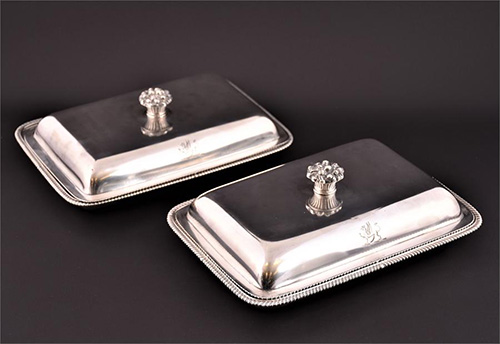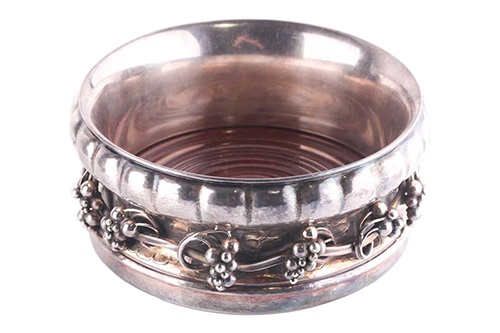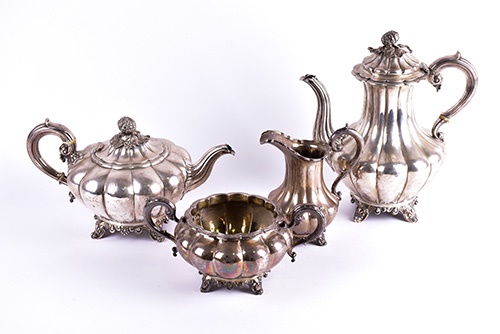How do I identify Antique Silver?
Discovering an antique piece of silver can be both exciting and also financially rewarding...
Antique Silver can be dated (via British hallmark) back to the early 14th century, and the most sought-after pieces can be extremely valuable indeed.
16/02/2022
As one of the earliest metals used by man, Silver has had many important uses throughout history; including being used as a form of currency. On the periodic table, it is grouped together with Gold and Copper, as all three have similar properties and are frequently found together in nature. They are also often used together in production. Silver is one of the most malleable and ductile of all metals, it can be beaten out into sheets, or drawn into fine wires, it can be worked into virtually any shape or form. It also happens to be self-sterilising, very useful in the medical field, and a fine conductor of heat and electricity.
Antique Silver can be dated (via British hallmark) back to the early 14th century, and the most sought-after pieces can be extremely valuable indeed.
So how can you tell if your silver is antique?
A fine pair of George III silver entrée dishes by Paul Storr.
It may well look silver…
Of course, we would expect a dead giveaway to be the colour… If something is silver in colour – then it must be silver, right? Well, it’s a bit more complex than that. For starters, many antique silver pieces were gilded – this means that a very fine layer of gold is applied, changing the colour, appearance, and quality of the item. Silver also corrodes over time, and older pieces can often be tarnished dark brown or black in colour.
In addition, there is silver plate to consider, where a fine layer of silver has been applied to a piece of metal to give the appearance of being silver at a fraction of the cost. The types of plating we encounter most often are:
Close Plating: Iron or steel is covered in silver using tin as the binding agent
Old Sheffield or Fused Plating: A copper ingot was covered and fused with a sheet of sterling silver, undoubtably the finest form of all plating methods
Electroplating: Electrolytic process is used to plate base metal or nickel silver
Wear to the silver plating will often reveal patches of base metal or copper – which will make it easier to determine composition.
An early 20th century Georg Jensen "Grape Pattern" (229) circular silver wine coaster.
The oldest form of consumer protection – hallmarking
Silver hallmarks are one of the most important factors in identifying all silver. Small, stamped symbols can tell you almost everything about a piece; where and when it was made, by whom, as well as the purity of the silver. Understanding how to read silver hallmarks is an important and necessary skill for any antique silver enthusiast.
Most countries have their own set of hallmarking legislations and requirements. In England, there are typically four or five small stamps – either the Lion passant symbolising 925 sterling silver, the lion head erased or “Britannia” symbolising 958 silver standard, the town mark (an anchor for Birmingham, a Crown for Sheffield, a Leopards head for London, etc), the date letter and the maker’s mark – additional marks such as the monarchs head can be present and this signifies that duty was paid on the weight of silver when it was manufactured. So called “Duty Dodgers”- where a smaller piece such as a watch case was hallmarked and then placed into a larger items such as a punch bowl are still illegal today even when the crime was committed in the 18th century.
Earlier surviving pieces may have less hallmarks, due either to their age or wear. An Act of King Edward I, which became law in 1300, required a leopard’s head to be struck on English gold or silver – this made it possible for officials to identify an item as English, and also what standard it had been struck under. Thus, the practice of hallmarking first began, and evolved over time to include the additional hallmarks we are familiar with today. Investing in a good hallmarks guide book will enable you to decipher these marks. There are also several very useful websites dedicated to the identification of International hallmarks and maker’s marks.
Another consideration is that these marks can be worn and faked – so an understanding of other characteristics, style and features is required should you decide to become an avid collector.
Silver plate will often be hallmarked with the purpose of confusing the customer about the nature of the metal alloy, electroplate usually has the letters “EPNS” or “EPBM” present. As always, knowing and researching your hallmarks can provide valuable information.
A Victorian four-piece silver tea set. London 1849 by Edward, John & William Barnard.
What other factors should you consider?
Over time, you will find some features become second nature when identifying silver.
- Locations of hallmarks – sometimes they can be hidden. Often Victorian teapots will have partial hallmarks on removable parts such as the finial
- Silver has a distinct smell/odour
- You will begin to get a better feel for the weight of a piece – if it feels like silver, or perhaps a plated item
- Style and type of decoration often give clues to age: Chasing, Engraving, Embossing, Bright-Cut and Engine Turning
Collecting
Most enthusiasts collect according to a style or theme, this can be anything from rococo to neo-classical, Art Deco to Art Nouveau, or even a type of item, for example vinaigrettes or basting spoons, or a specific maker like Paul Storr, Omar Ramsden, or Georg Jensen. It’s really about what appeals to your senses.
There are several factors to consider regarding condition, all of which will affect the value of the silver piece:
- Hallmarks: are they clear, worn, complete?
- Good surface colour
- Original condition – lack of repair or restoration
- What damage, wear or distress is present
- Alterations: in 1844 it became an offence to alter or make an addition to a piece without hallmarking accordingly, and unfortunately makes them illegal to sell on the market today
read more
How to Tell if Antique Silver is Real?
The expert team of Valuers at Dawsons would be happy to help you identify your antique silver. Please do get in touch should you have any queries, or maybe you have a piece of silver you would like to have valued.
We would love to hear from you.
Call us: 0207 431 9445 or get in touch via email: info@dawsonsauctions.co.uk


